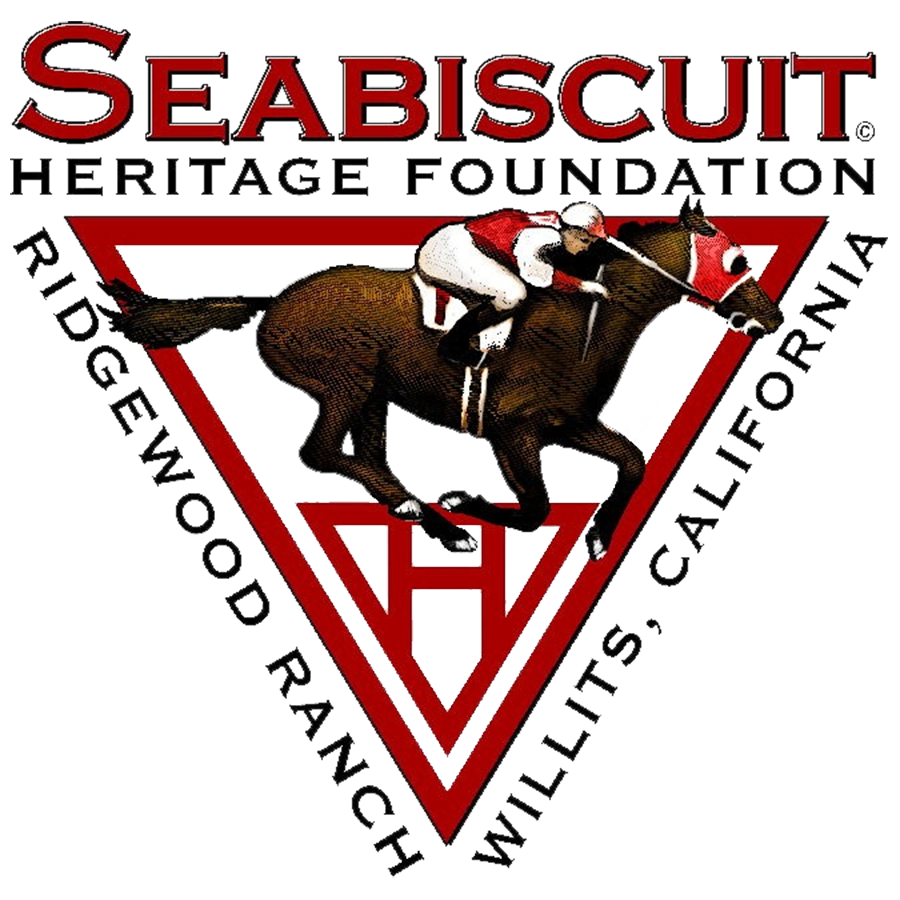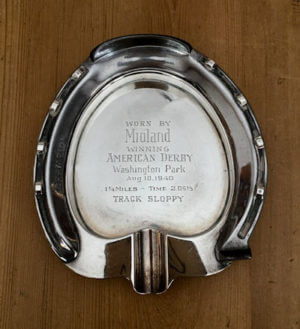Ridgewood Ranch, Mioland and Nazis
by Colonel Michael C. Howard, US Marines (Ret)
Seabiscuit Heritage Foundation Historian
Here is a unique Howard Family story about history and heritage. How an Oregon Thoroughbred, who’s Sire was snuck out of Nazi Germany, grew up at Ridgewood next to Seabiscuit and raced in the Kentucky Derby.
Special Note: This article is humbly dedicated to the Memory of Technical Sergeant Raymond Lavern Allen (1919-1945), U.S. Army, 1st Cavalry Division, KIA (8 March 1945) while on patrol in the Philippines, WWII. He was a respected Exercise Rider & Ranch Hand for the Howard Family, Ridgewood Ranch. Mioland lost a good friend. To learn more about Raymond Lavern Allen’s story, please read FOR HORSE AND COUNTRY here.
History can be fascinating.
In 1930’s Nazi Germany, after Hitler came to power, the Third Reich issued strict guidance within its Thoroughbred racing industry that Germany’s top horses would not be exported and sold. It seems that “Aryan Blood” lines and racial purity did not just apply to people.
German Blood Certificates (German: Deutschblütigkeitserklärung) were documents provided by Hitler to ‘Mischlinge’ (those with questionable bloodlines or impure heritage). Mischling is a term used during the Third Reich era in Germany to denote persons (and later livestock) deemed to have partial or impure ancestry. This word literally means “mixed”. These certificates were a form of Nazi bureaucratic authenticity declaring the subject deutschblütig (of German blood). This practice was begun sometime after the Nuremberg Laws of 1935, and allowed exemption from most of Germany’s ever more strict racial laws. Soon after these new standards were imposed on the general civilian and military population, they also inevitably crossed over and were applied to other areas of society. The German Thoroughbred horse racing industry was no exception. These orders were created for the strict purpose of maintaining blood purity of the Aryan race and related to the “preservation” of all things Teutonic German. For racehorses, this had always been important, but it now took on an extremely serious political, focused goal on blood, honor, and purity of all things Aryan.
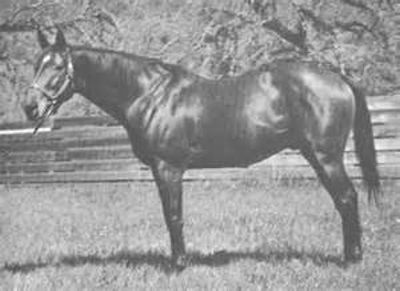
Enter upon the scene a top German Thoroughbred named Mio d’Arezzo. He was a successful stallion who had won the prestigious Deutches St. Leger. Though one of the top racing horses in Nazi Germany, this horse had a prominent Italian name which kept him off the German horse racing skyline. The Nazi media did not take to him as his name suggested and could be considered an indication of equine “mixed-blood and questionable race”.
Enter also onto the mid-1930s scene Dr. Harold W. Ray, a devoted American horse-breeder out of Hillsboro, Oregon, with considerable European and specifically German horse racing connections. He secretly purchased Mio d’Arezzo as a five year old. Dr. Ray, through “low friends in high places” was able to adroitly and in a timely manner, take advantage of the new Nazi re-organization. Using great creativity, he was able to get Mio d’Arezzo shipped out of a northern German port among a large consignment of German draft horses. The latter, used for pulling beer wagons or German Army artillery, did not appear to draw the attention of custom’s official lacking a keen eye for equine quality. Tragically for the world, Nazis were more focused on human (Jewish) flesh, than horse flesh.
Thus Mio d’Arezzo was expeditiously and quite successfully exported from Nazi Germany. Bound for America, he was shipped across the Atlantic to New York, and there transported by rail from the East Coast westward to San Francisco. Here Dr. Ray connected with his good friend Charles S. Howard (my Great Grandfather), where they discussed possible future stud results. Both were solid believers in improving the West Coast Thoroughbred horse racing industry. Howard delighted in this story of tricking the Nazis! From San Francisco, Mio d’Arezzo was shipped north to Portland, Oregon, where he finally settled down into a sweet breeding program at Hawthorne Farm, in beautiful Washington County, outside the town of Hillsboro, Oregon.
Hawthorne Farm was owned by Harold Ray. The Ray-Maling Company was Hillsboro’s largest employer in the 1920’s & 1930’s. The Hawthorn Farm stables faced Shute Road, not far from the prominent Washington County Courthouse. The main barn (828’ long by 48’ wide) had room for 38 horses. It had a covered exercise track around the stalls. Overall, Hawthorn Farm consisted of 320 acres devoted principally to paddocks, and was considered one of the finest Thoroughbred breeding farms in Oregon.
Harold Ray bred Mio d’Arezzo with Iolanda, a sound mare with a reliable reputation. This pair proved a solid couple as a sire and dam in producing a beautiful bay foal in 1937. He was named Mioland (pronounced “Mee-o-land”), honoring his European father and his new American home. He has a lot going for him: his Grandsire was Laland and his Damsire was Vespasian.
In 1939, Charles S. Howard and his wife Marcela (my “Auntie Mar”) made the short trek up to Portland, Oregon, by train and in one of the Buicks (he preferred a special 1931 Phaeton in Algonquin Green), drove out from his Portland Howard Automobile Company agency on Burnside Avenue, Portland, to Hawthorne Farm, Hillsboro.
My Great Grandmother Marcela said that just like Seabiscuit at Saratoga Springs, NY, seeing Mioland for the first time on a beautiful Oregon spring day was ‘love at first sight’. Harold Ray pointed out that Mioland was a natural “mudder” having acquainted himself well already to Oregon rain. At age two, Mioland was regularly ridden by Earl Drew, who won several races aboard the colt at local California racetracks. The Howards were thrilled with their purchase. Mioland had a winning personality and soon made the trip south to his new home at Ridgewood Ranch, just south of Willits, California. Little did he know the team he was now on!
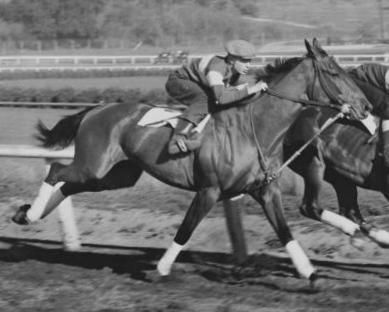
Mendocino County and raising under trainer “Silent” Tom Smith agreed with Mioland. Plus his stablemate mentors were none other than Seabiscuit and Kayak. He would also later meet Ajax (one of Australia’s greatest Thoroughbred studs) and the legendary big Irish stallion Noor. Rarely was there ever such a collection of American equine quality under one roof than here at Ridgewood. Mioland was also fortunate to be coupled most of the time with jockey Johnny “Red” Pollard, who was no longer riding the retired Biscuit.
Mioland was known within the Howard Family as the “Oregon Mudder whose sire was snuck out of Nazi Germany”.
To me he was a legend and I cherish the silver horseshoe I have of his. Mioland had a good life (1937 to 1951) and proved himself to be an American champion stakes winner with an earnings total of $244,270.00. Mioland had a solid record: he won 11 stakes races, coming in second 7 times, and third 3 times. He won the American Derby at Washington Park on 10 August 1940 with an amazing one and one quarter miles in a time of 2.05 and 1/5th on a … yes you guessed it … very sloppy track! This race endeared him to my Dad, Lin Howard Jr., who recalled to me years later that this is where Charles S. Howard and Tom Smith first taught him about the “Louisiana Grabs” horse-shoe for muddy tracks. I remember this with the distinctive “cup” at the front of the shoe when a farrier pointed this out to me one time as he put them on. Funny what kids remember.
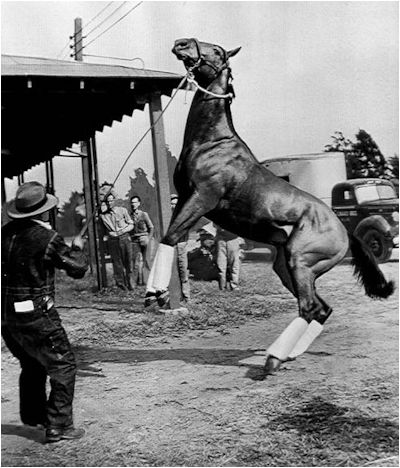
Mioland got a lot of Howard Family attention, and from across America, when he ran in the 1940 Triple Crown (the same year that Seabiscuit retired). In 1940, Mioland won the Potomac and Westchester Handicaps, proving again the abilities of US West Coast horses in the Northeastern United States. But as my Grandfather and Father used to say: “Life is a horse race.” Mioland’s big 1940 entry in the Triple Crown was disappointing. In the Kentucky Derby, Mioland, with jockey Lester Balaski, came in 4th with the race being won by Gallahadion. In the Preakness Stakes, Mioland ran a very respectable 2nd to Bimelech. And for some unknown reason, Mioland did not run in the Belmont. But he did later take a 2nd in the 1941 Santa Anita Handicap, where he lost to Bay View (50 to 1 odds) by half a length. And this was on a sloppy track.
Mioland also won the prestigious American Derby at Chicago. He remained on the West Coast of the United States where he won three important races in 1941, including his second consecutive San Juan Capistrano Handicap. What makes his back-to-back wins even more notable is that the 1940 win was at a distance of 1 1⁄16 miles, but the 1941 win came at the much longer distance of 1 1⁄2 miles. Mioland’s 1941 performances earned him American Champion Older Male Horse honors from Daily Racing Form.
Mioland raced at age five on the United States East Coast, where his best results were a record-breaking win in the 1942 Coral Gables Handicap at Tropical Park, a second-place finish behind Challedon in the Philadelphia Handicap at Havre de Grace Racetrack, and a third in the Dixie Handicap to 1941 Triple Crown winner Whirlaway.
Retired to stud duty at Ridgewood Ranch, Mioland had limited success as a sire but did get several winners of minor races. He died in 1951, the same year Ridgewood Ranch was sold following the 1950 death of Charles S. Howard. Sadly, like Seabiscuit, Mioland passed away at the relatively early age of fourteen. Remembered by his California fans, Mioland was honored in Los Angeles, California, by having Mioland Drive named after him.
Mioland’s total lifetime earnings were $244,270.00 (more than half the winnings of Seabiscuit) with a total record of 50: 18-10-6.
Yes, in some ways it is tough being a stablemate of Seabiscuit, and sharing a stud barn with Kayak, Ajax and Noor. Few today remember the great bay stallion Mioland, whose father was snuck out of Nazi Germany among a consignment of draft horses.
But the Howard Family still remembers him, and now maybe so will you! He is undoubtedly one of the finest Thoroughbreds ever to come from Oregon.
If you want to see Mioland in muddy action (and Bing Crosby pulling for another Howard horse), please check out this footage in the slop of the 1941 Santa Anita Handicap. It is a great horse race, even if the Howard horse does lose:
